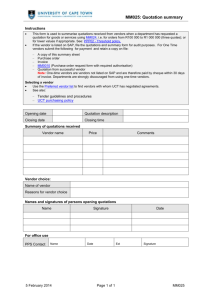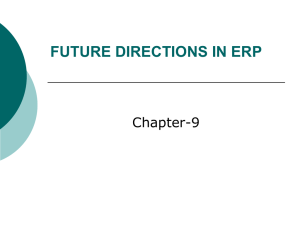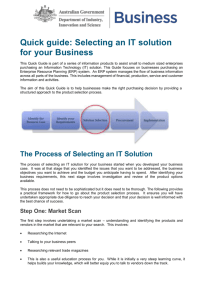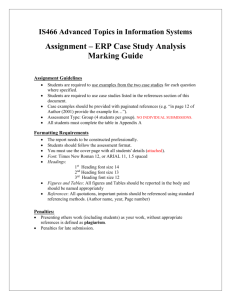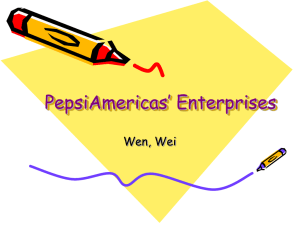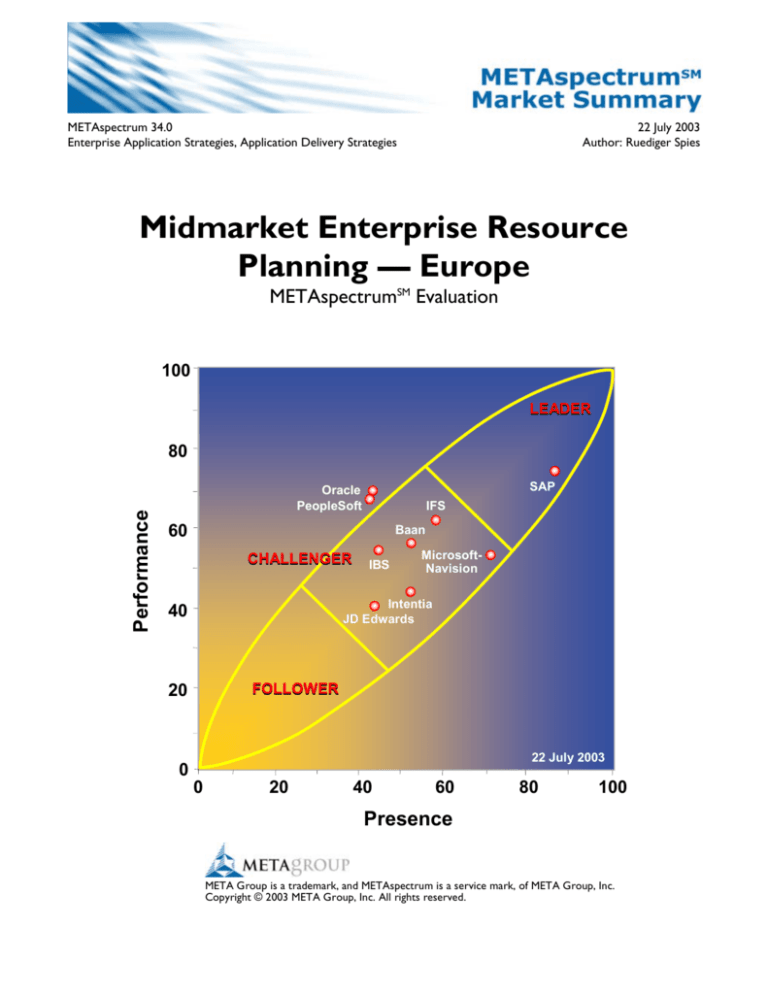
METAspectrum 34.0
Enterprise Application Strategies, Application Delivery Strategies
22 July 2003
Author: Ruediger Spies
Midmarket Enterprise Resource
Planning — Europe
METAspectrumSM Evaluation
100
LEADER
Performance
80
SAP
Oracle
PeopleSoft
IFS
60
Baan
CHALLENGER
MicrosoftNavision
Intentia
JD Edwards
40
FOLLOWER
20
0
IBS
22 July 2003
0
20
40
60
80
100
Presence
META Group is a trademark, and METAspectrum is a service mark, of META Group, Inc.
Copyright © 2003 META Group, Inc. All rights reserved.
Market Overview
Market Definition
This METAspectrum investigates the midmarket enterprise resource planning (ERP) market in Europe. The larger territory —
EMEA (Europe, Middle East, and Africa) — is also reflected, but the key focus is on geographical Europe. ERP is defined as a
suite of enterprise business applications including, at a minimum, financials and human resources applications, plus at least one
of the following: manufacturing, supply chain management (SCM), or customer relationship management (CRM). ERP solutions
should be capable of satisfying at least 75% of the overall business requirements for target customers. ERP application
functionality is mission-critical, and solutions are therefore regarded as core IT investments. This is independent of the target
customer size, applying equally to large and midsized enterprises.
The focus of this METAspectrum is on enterprises with between 50 and 1,000 employees and annual revenues of less than 1B
euros. We refer to this space as the midmarket or the small and medium business (SMB) market. There are roughly 200,000
enterprises in this territory. For an ERP vendor to qualify for inclusion in this study, its license revenue in the last business year
must have exceeded 50M euros. License revenue better reflects the footprint in the market than total revenue including
services, because it treats direct and indirect selling companies equally.
Market Forecast
During 2003/04, reduced spending on new ERP projects by Global 2000 (G2000) firms will cause Tier 1 ERP vendors to focus
more on selling into the midmarket. Among Tier 1 vendors, some have packaged their existing ERP offerings to better
accommodate the needs of the midmarket, while others have developed offerings specifically for the midmarket. Tier 2 ERP
vendors, on the other hand, have largely served the extended midmarket as a matter of course and thus have not needed to
create special offerings.
The Tier 3 vendor landscape and part of Tier 2 continue to consolidate (e.g., Navision has been acquired by Microsoft, the
ownership of Baan has just changed), opening opportunities for vendors to win replacement business. Many midrange
customers have older ERP systems (or parts thereof), homegrown applications that must be replaced, or applications from
vendors that have gone out of business.
However, Tier 1 ERP vendors currently do not have an optimized offering (product plus service plus integration plus
midmarket pricing) for the midmarket. In 2004/05, we expect Tier 1 vendors to have finally optimized their offerings for the
SMB market, leaving less and less of the market to Tier 2 suppliers. The market will continue to consolidate until 2006/07, and
we expect overall growth to be flat over the next couple of years.
We also believe ERP vendors will have a much stronger chance of fulfilling the role of the enterprise backbone in the SMB
market than they do in the G2000 environment. Midrange companies tend to expect that their (relatively fewer) software
vendors will solve all their business application-related questions. The value of an integrated environment counts more in this
environment, since SMBs lack the resources to support costly application integration themselves. Due to the sheer number of
midmarket companies, the relatively modest revenue per deal, and local support requirements, we expect most ERP vendors
serving this market to develop a comprehensive partner strategy. Those without one will be relegated to niche status in this
market by 2005/06.
Key Findings
The midrange ERP market is fragmented, with one company dominating most discussions but certainly not all purchasing
decisions. Although that company — SAP — is still seen as the vendor of choice for G2000 enterprises, this perception is
slowly changing. The other vendors reflected in this METAspectrum (Baan, IBS, IFS, Intentia, JD Edwards, Microsoft Business
Solutions, Oracle, and PeopleSoft) are all challenging SAP to various degrees. In general, the market is balanced between the
need for presence and performance. Vendors must excel equally in both to be successful. Especially in light of the current tight
market, we consider financial stability a key criterion, because decisions regarding an ERP system often have consequences
extending out for 10 years.
Nevertheless, we do not expect a consolidation as severe as that of the database market (down to three main vendors),
because of the complexity of requirements in different vertical markets. However, we do expect a consolidation down to five
vendors that will address the complete market spectrum by 2005. Other vendors will survive to specialize in a limited number
of vertical industries. Tier 3 vendors will not be able to serve the complete European/EMEA territory with all its languages,
currencies, and legal requirements, and are therefore at a serious disadvantage. End users selecting a new ERP vendor should
seek a balance between the right level of functionality (i.e., avoiding overengineered solutions) and the appropriate pricing level.
208 Harbor Drive • Stamford, CT 06912 • (203) 973-6700 • Fax (203) 359-8066 • metagroup.com
Copyright © 2003 META Group, Inc. All rights reserved.
METAspectrum 34.0 Midmarket ERP — Europe
2
Market Overview
Leaders
Given SAP’s omnipresence in the European market, it is not surprising that its position is near the far right edge of the leaders
sector. The brand influence from G2000 deals is immense. However, SAP does not have a seamless offering in the midmarket
(SAP All-in-One and SAP Business One have different architectures); therefore, its ranking is derived from a mixture of its
offerings. From a functional perspective, we see Oracle’s offering for the midmarket as more or less equivalent to SAP’s
offering. However, Oracle’s presence in the market is far behind that of SAP, and we believe Oracle will try to become more
visible with its new partner strategy. Although PeopleSoft also ranks high in performance, its offering is not suited for the
lower end of the SMB market, nor does the vendor want to expend too much of its energy on small companies. PeopleSoft’s
marketing campaigns are, therefore, targeting the higher end of the midmarket.
Challengers
Similar to SAP in the leaders sector, Microsoft Business Solutions is near the right-hand edge of the METAspectrum shape due
to its presence in the market. The takeover of Navision by Microsoft improved Navision’s visibility and covered the dualarchitecture problem to a degree (ex-Navision, ex-Axapta, and also ex-Great Plains products). Baan, IBS, IFS, Intentia, and JDE
are well positioned in the challenger area. PeopleSoft, being a Tier 1 vendor, has focused much of its efforts on G2000
companies and thus must battle its unequal presence in different European markets. In this sense, PeopleSoft could also be
considered a follower in the broader sense of the midmarket, due to its limited focus on this constituency.
Followers
There are no vendors designated as followers in this market analysis. The main reason is that we selected an entry barrier for
this market analysis of 50M euros in license revenue in the Europe/EMEA territory. There are many more small ERP vendors
serving select territories, and the vendors examined here see fierce competition from these smaller/lower-presence vendors.
Bottom Line
The market for midrange ERP in Europe continues to be fragmented, leaving many choices for potential buyers.
Tier 1 ERP vendors have tried to compensate for declining revenue from G2000 companies by concentrating more
on the midmarket. This situation will drive consolidation, with the number of global general-purpose ERP midrange
vendors diminishing to five by 2005. However, a substantial number of global and local vendors will continue serving
the market. Given the multitude of options, mistakes can easily be made when selecting an ERP vendor. End users
must seek a sound functional fit (no oversized solutions), low maintenance fees, a good balance between
implementation cost and software license, and a financially stable partner.
Business Impact: Because of expected consolidation in the market and the long-term commitment inherent in
selecting an ERP system, buyers must look intensively at vendors’ financial condition. ERP vendors must be able to
continually invest in new technologies to support customers’ ongoing drive for better IT and business alignment.
Vendors should also have a proven track record of innovation in improving the value of the original ERP investment.
208 Harbor Drive • Stamford, CT 06912 • (203) 973-6700 • Fax (203) 359-8066 • metagroup.com
Copyright © 2003 META Group, Inc. All rights reserved.
METAspectrum 34.0 Midmarket ERP — Europe
3
Midmarket ERP — Europe Presence Evaluation
Our market presence evaluation includes a review of each vendor’s product and service attributes — representing vendors’
ability to deliver value to customers. The following seven criteria areas provide a summary of our presence analysis. For
complete details on how vendors fared with each criterion in our evaluation, visit metagroup.com.
Vision/Strategy
Channels/Partners
SAP
IFS
IBS
Intentia
JD Edwards
Microsoft-Navision
Baan
PeopleSoft
Oracle
Excellent
Good/Very Good
Good/Very Good
Good
Good
Good
Fair/Good
Fair/Good
Fair
SAP
Microsoft-Navision
Oracle
Baan
JD Edwards
IFS
PeopleSoft
Intentia
IBS
Excellent
Very Good
Good/Very Good
Fair
Fair
Fair
Poor/Fair
Poor
Poor
What We Evaluated
What We Evaluated
Messaging/Positioning — External visible communication
to the market about vision, views, expectations, priorities,
and values, including how these values are communicated.
Customer Life-Cycle Management — Level of industry
acceptance of messaging/positioning. Trustworthiness of
messages and customer confidence that the vendor will
keep its promises.
Innovation/Thought Leadership — Ability to generate
market-shifting ideas and incorporate those into the
product offering. Ability to articulate innovative ideas to
the market and position the company as having leadingedge domain expertise.
Business Impact of Channel — General assessment of
external sales and implementation capacities. The degree,
vitality, revenue, growth, reach, coverage, and profit of
active channels and partners. Includes relationships
between partners and vendor, ease of partnership, and
ability to manage channel conflicts.
Programs for Resellers — General support of the external
channel. Defined offerings, tools, requirements
management, programs, and incentives, as well as their
distinct value for partners, resellers, and ISVs.
Programs for SIs and Influencers — Defined offerings,
tools, requirements management, programs, and incentives,
as well as their distinct value for systems integrators (SIs)
and other influencers. Also, an understanding of all
parameters influencing the public’s opinion about a vendor
— and management of them.
Quality Assurance for Channel — Defined methods to
ensure the quality, consistency, and value delivered by
individual partners for the final benefit of the end customer.
Analyst Commentary
This criteria area received the highest weighting in the
presence category, because successful ERP vendors must
not only develop a compelling product offering, but also
articulate a sound vision for how the offering adds value.
Ideally, this vision statement demonstrates a deep
understanding of customer requirements. Regardless, it is a
clear indicator of whether a vendor rates customer or
company priorities higher. The longer the duration of the
vendor/customer relation, the more important it is for a
vendor to demonstrate a long-term commitment to the
customer. This normally translates to high marks in
customer life-cycle management, as vendors and customers
have to go through many upgrades and enhancements to
the original software. Intentia, JDE, and SAP got high marks
in this regard due to their deep commitment to delivering
customer value as reflected in their vision statement.
Innovation is another important subcriterion, due to the
longevity of a typical ERP system. Vendors must
continuously demonstrate that they can keep up with
competition and market developments, introducing new
functions based on modern technology for the benefit of
their customers.
Analyst Commentary
ERP vendors must develop and maintain partnerships to
ensure long-term survival and improve market penetration.
Reselling partners clearly enhance a vendor’s visibility and
market footprint. Microsoft Business Solutions scored well
here due to its strong commitment to partners. In addition,
SAP received good marks for its channel concept that has
gained traction. Even if its ecosystem of hardware partners,
systems integrators, partners with additional software, and
resellers is highly complex, SAP has developed a unique
model of how to manage all the relationships without
showing a disjointed face to its customers. Some vendors
have chosen to work without any partners or with a very
limited set to offer a one-stop shopping opportunity for
midmarket customers and ultimately to control the
implementation’s quality. However, we believe this is done
at the expense of market visibility and penetration. We are
convinced that this strategy will eventually drive vendors
opting for that approach into a niche position.
208 Harbor Drive • Stamford, CT 06912 • (203) 973-6700 • Fax (203) 359-8066 • metagroup.com
Copyright © 2003 META Group, Inc. All rights reserved.
METAspectrum 34.0 Midmarket ERP — Europe
4
Midmarket ERP — Europe Presence Evaluation
Awareness/Reputation
SAP
Microsoft-Navision
Oracle
PeopleSoft
JD Edwards
Baan
IFS
Intentia
IBS
Geographic Coverage
Good/Very Good
Good/Very Good
Good
Good
Good
Good
Good
Fair/Good
Fair/Good
SAP
IBS
Intentia
Microsoft-Navision
Baan
IFS
JD Edwards
Oracle
PeopleSoft
Very Good
Good/Very Good
Good/Very Good
Good/Very Good
Good
Good
Fair/Good
Fair
Fair
What We Evaluated
What We Evaluated
Mind Share — Action and effectiveness in terms of
publicity, sales, marketing, service, and development
activities that build positive perception in the market and
extend visibility above and beyond the organization’s size
and/or share.
Vendor Reputation — The measurable achievement of
visibility as demonstrated by direct and indirect activities
including publications, press engagement/coverage, and
analyst/key influencer visibility. Also, the market’s
perception of the vendor vis-à-vis customers and partners,
investors/analysts, and employees.
Importance of Business in Europe/EMEA — Weight of
vendor’s European business compared to overall company
business. Considers vendor’s focus on this region as well as
the percentage of its revenue coming from EMEA. Also
looks at the vendor’s ability to attract new business in this
region.
Split of Business in EMEA Countries — How equally
distributed the vendor’s business in Europe is, the level of
potential support in different countries, and resources
available — also with respect to partners (e.g.,
implementation).
Leverage — Ability to generate growth, profitability, and
new customers from non-headquarters regions.
Analyst Commentary
Awareness in the industry must not be confused with market
share. Mind share is often reflected in a vendor’s probability
of making a shortlist, because it also reflects the political
enforceability in a given enterprise. Although the vendors
evaluated in this research are typically adept at presenting
their respective cases in competitive sales situations, making
shortlists is a huge challenge for many. A vendor’s image of
being a trusted long-term fair partner plays a sizable role in
buying decisions. And reputation cannot be changed
overnight simply by adding more money to the marketing
budget. These are long-term influences that have been built
over time and are part of a company’s brand. Furthermore,
negative press can quickly damage the hard-won reputation
of a vendor. For the market analyzed here, SAP received
high marks due to its ability not to overuse its size and its
broad reputation as a fair market participant.
Analyst Commentary
Balanced distribution among the various European
countries is interpreted here as an indicator of good overall
acceptance, as a stable basis for future business, and as a
sign of the vendor’s ability to expand internationally. A
couple ERP vendors with good reputations in the American
market have not been included in this study, due to their
inability to generate enough revenue in foreign territories
(like Europe). On the other hand, we have included several
European ERP vendors that do most of their business in
Europe (e.g., IBS). Due to the characteristics of midrange
customers, it is often not critical to have a worldwide
presence. Consequently, we put much more weight on
European presence and the ability to serve customers
equally in all European countries.
208 Harbor Drive • Stamford, CT 06912 • (203) 973-6700 • Fax (203) 359-8066 • metagroup.com
Copyright © 2003 META Group, Inc. All rights reserved.
METAspectrum 34.0 Midmarket ERP — Europe
5
Midmarket ERP — Europe Presence Evaluation
Industry Focus
Investments
Intentia
IFS
Microsoft-Navision
SAP
PeopleSoft
Baan
IBS
Oracle
JD Edwards
Very Good/Excellent
Very Good
Very Good
Good/Very Good
Good/Very Good
Good
Good
Good
Good
SAP
Microsoft-Navision
Baan
IFS
PeopleSoft
Intentia
Oracle
IBS
JD Edwards
Excellent
Very Good/Excellent
Very Good
Very Good
Good/Very Good
Fair/Good
Fair
Fair
Fair
What We Evaluated
What We Evaluated
Vertical Coverage — Number of vertical markets
addressed, number of customers and/or percentage of
revenue in verticals, and available references in vertical
markets. Also, demonstrated market share strategy, depth
of product offering, and domain knowledge of personnel in
vertical markets.
Depth of Experience — Measured, demonstrable tools,
techniques, methods, certifications, primary research,
tailored approaches, or other analysis and delivery
attributes that highlight the relevant skills and expertise
brought to a particular market.
Research and Development — Ownership, investments,
or relationships tied to business areas that are horizontally
or vertically complementary to the core market business.
Access to specific, exclusive intellectual property. Spending
in R&D relative to the revenue.
Targeted Growth Areas — Planned and active investment
areas tied to business growth.
Acquisitions — Success in selecting, buying, and integrating
companies and technologies.
Analyst Commentary
A vendor’s domain expertise surrounding industry-specific
business processes has become critical for facilitating
application implementation and reducing upfront application
customization. Most midrange ERP vendors have selected
certain vertical industries on which to focus sales,
marketing, and development activities, whereas the Tier 1
vendors tend to argue that their packages are broad
enough to be tailored to any given industry. For this
criteria area, we looked at the breadth of industries
covered by the vendors as well as the depth of expertise
and packaging demonstrated for each offering. Due to the
backbone nature of ERP systems, the key to vendor
success is an ability to demonstrate vertical expertise
through investments in process experts that can align easily
with client business rules and processes. Leveraging
business partners with the required industry expertise is
another alternative used by vendors.
Analyst Commentary
Competitive differentiation through investments in leadingedge technologies, along with the percentage of revenue
invested back into research and development,
demonstrates a clear focus on product excellence. These
investments result in a steady stream of functional and
technological enhancements that enable competitive
leadership. Such enhancements are normally the result of
investments either directly in research and development
(this should be the primary force) or in new technologies
gained through the acquisition of smaller companies to
close functional gaps quickly. SAP’s investment level tends
to be high, even if the company does not always acquire a
complete company to gain access to new technology
(though TopTier and TopManage are exceptions). On the
other side are the acquisition levels of IBS and Oracle,
which for the ERP space are relatively lower.
208 Harbor Drive • Stamford, CT 06912 • (203) 973-6700 • Fax (203) 359-8066 • metagroup.com
Copyright © 2003 META Group, Inc. All rights reserved.
METAspectrum 34.0 Midmarket ERP — Europe
6
Midmarket ERP — Europe Presence Evaluation
Share
SAP
Microsoft-Navision
Oracle
PeopleSoft
JD Edwards
Baan
IFS
Intentia
IBS
Excellent
Very Good
Good
Good
Good
Good
Good
Good
Fair
What We Evaluated
Market Share — Share of market relative to competitors
in the target market. Only revenues for application
software are relevant. Additional service revenue is not
factored in here.
Analyst Commentary
In today’s uncertain market, share — encompassing mind,
market, and wallet share — has assumed a renewed
importance. Customers want to ensure that they can live
and work well with their vendors for a long time. ERP
backbone decisions are never tactical, and customers need
a certain level of assurance that their ERP vendors will
survive the next 10 years. We also see vertical coverage as
an influence on this criteria area. Vendors with the greatest
share have already established the ultimate testimony about
the acceptance of their application in many different vertical
markets. Market share will continue to be a proof point for
acceptance in the European market.
208 Harbor Drive • Stamford, CT 06912 • (203) 973-6700 • Fax (203) 359-8066 • metagroup.com
Copyright © 2003 META Group, Inc. All rights reserved.
METAspectrum 34.0 Midmarket ERP — Europe
7
Midmarket ERP — Europe Performance Evaluation
Our market performance evaluation includes a review of each vendor’s product and service attributes — representing
vendors’ ability to provide value to customers. The following seven criteria areas provide a summary of our performance
analysis. For complete details on how vendors fared with each criterion in our evaluation, visit metagroup.com.
Technology
PeopleSoft
Oracle
IFS
Intentia
SAP
IBS
Baan
JD Edwards
Microsoft-Navision
Good/Very Good
Good/Very Good
Good/Very Good
Good
Good
Good
Good
Fair/Good
Fair/Good
What We Evaluated
Architecture — Kind of architecture that is used (C/S, 3tier, 4-tier, pure Web, mixed), openness, standards used,
platform supported, open data model, DBMS supported,
extensibility by clients, proprietary/open development
language for extensions. Architecture consistency.
Core ERP Features/Functions — Optimization, planning,
and scheduling models supported. Link and integration to
factory-floor systems (where appropriate), flexibility in
methods used for optimization, and collaborative
execution. Service management and special vertical
extensions (e.g., for flow-oriented manufacturing).
Financials Features/Functions — General ledger,
accounts receivable, accounts payable, procurement
(purchase to pay process), asset management, expense
management, and support for new government regulations
(e.g., Basel II, Sarbanes-Oxley Act).
HR Features/Functions — Core HR functions, payroll
(multicountry), benefits, administration, hiring, performance
management, compensation, career development,
succession planning, and HR self-service functions.
Strategic Enterprise Planning and Management —
Integrated tools for enterprise planning, business planning,
enterprise performance management, and parallel
simulation of different scenarios.
Analytic Features/Functions — Integrated tools for
reporting, detailed query, DW functions, key performance
indicators, dashboards, balanced scorecards, accessibility by
external tools, OEMed analytics package, and business
consolidation.
SCM Features/Functions — General supply chain
planning, collaborative planning, collaborative sourcing, level
of support for supply execution, work management system,
logistics, service management, collaborative manufacturing,
support for TOC (theory of constraints), and supply chain
event management.
CRM Features/Functions — Integrated functions for
operational, analytical, and collaborative CRM, vertical
CRM offerings, and level of integration into ERP/SCM
system. Also, whether the CRM functionality is from an
external partner or is part of core vendor’s expertise.
Portal Framework — Whether a portal framework exists,
whether the suite is accessible via a portal, and whether an
external partner’s portal software is used. Also, ease of use
in a Web environment, network traffic requirements, and
efficiency in terms of using network resources.
EAI Features/Functions — Existence of a specific
integration framework as part of the ERP system, ease with
which functions can be accessed from the outside, and
support for modern integration standards (e.g., Web
services, XML, BPEL4WS).
Application Management Tools — Specific rules
declaration/management, application configuration,
application extensibility, visual modeling/workflow,
design/development environment, testing support, patching,
complexity, implementation time, upgradability, and tools
for upgrade support.
Analyst Commentary
Technology/functionality offered is by far the most
important selection criterion for customers and
consequently the most heavily weighted of the
performance criteria. It represents the heart of any
solution. Good product architecture is reflected in the
ability to seamlessly integrate newly acquired products and
to rapidly support emerging standards (e.g., XML, Web
services). Partnerships with other companies to fill
functional gaps have not been reflected in this study,
because they are open to any vendor and therefore result
in no real competitive advantage for a vendor. Core ERP
functions can be delivered by almost all vendors
investigated in this study, and are a prerequisite to play in
this league. However, points of differentiation exist in more
peripheral areas. Microsoft Business Solutions, for example,
lacks deeper analytical functions (not consistently available
among offerings and too report-oriented where present),
whereas SAP gets good marks for its All-in-One offering
with Business Warehouse (BW) but also lacks analytical
functionality in its Business One product.
208 Harbor Drive • Stamford, CT 06912 • (203) 973-6700 • Fax (203) 359-8066 • metagroup.com
Copyright © 2003 META Group, Inc. All rights reserved.
METAspectrum 34.0 Midmarket ERP — Europe
8
Midmarket ERP — Europe Performance Evaluation
Services
Pricing
SAP
Oracle
Baan
IFS
Intentia
PeopleSoft
IBS
JD Edwards
Microsoft-Navision
Very Good
Very Good
Very Good
Good/Very Good
Good/Very Good
Good/Very Good
Good/Very Good
Fair/Good
Fair/Good
IBS
Oracle
SAP
Baan
IFS
Microsoft-Navision
JD Edwards
PeopleSoft
Intentia
Very Good/Excellent
Good/Very Good
Good
Good
Good
Good
Fair/Good
Fair/Good
Fair
What We Evaluated
What We Evaluated
Business Process Methodology — Availability of
published implementation methodology, templates for
building add-on products, specific industry models, tools to
support change management, and integrated tools to
support the implementation project.
Implementation Services — Implementation services
offered and level of local vendor consultant capacity,
quality, skills, training, and certification. Sufficiency of
external resources in terms of availability and training.
Hosting Services — Vendor’s capabilities for hosting
services, internally or via established partnership with other
service providers. Also, availability of other usage models
(ASP, BPO, complete outsourcing).
Special Offerings for Midmarket — Special offerings the
vendor brings to the table for the midmarket (this
subcriterion very much targets Tier 1 vendors trying to
embrace the midrange market).
Pricing Strategies/Models — Type of general pricing
strategy (user-based, value-based, hardware performancebased), terms/conditions, and maintenance/support costs as
a percentage of revenue. Also, whether a pricing model is
publicly available and customers’ ability to see the
implications of usage changes.
Relative Costs — The relative cost of software, services,
and maintenance, taking into account existing discounts and
the vendor’s openness to negotiate.
Analyst Commentary
Weighted second in terms of performance (along with
vendor financials), services represent an important part of a
vendor’s offering. Quality of service can be controlled
much more easily when a direct sales model is employed
versus when the entire solution is sold via a partner
channel. In either case, special tools and control
mechanisms for quality assurance must be implemented.
The services criteria area in this evaluation covers the
entire scope of how vendor technology and functionality
are delivered to the customer. A factor receiving increasing
attention is the ability to deliver integrated implementation
methods, business process modeling tools, and easy-to-use
upgrade mechanisms. The more the industry recognizes the
importance of an “application center of excellence,” the
more post-implementation services will grow in
importance. Midrange enterprises are in favor of one-stop
shopping. Therefore, the willingness and ability of a vendor
to offer hosting services needs to be factored in as well.
Analyst Commentary
Because midmarket companies are highly price sensitive,
they need a clear calculation base for a new offering as well
as an idea of expected follow-on costs. Although most
vendors show flexibility in their pricing models (e.g., userbased, role-based, site license, engine-based, server-based),
most vendors try to hide the calculation base during the
price negotiations so that customers are not able to
perform any “what-if” calculations on their own. We
believe intensified price pressure and increasing customer
savvy in handling vendors — also in the midmarket — will
finally result in a more open pricing policy (by 2005/06).
Oracle deserves special mention because of its public price
model (on the Internet), though its maintenance and
upgrade fees are relatively high.
Another important metric is the cost of implementation
(i.e., the sum of hardware, software, and service costs) as a
ratio of software licenses. Our research indicates that IBS,
Intentia, PeopleSoft (with its midrange offering), and SAP
(with its Business One offering) have the lowest ratios.
However, this is sometimes offset in our ratings by
inflexible pricing models or the vendor’s inability to
communicate and ensure the value of a package
implementation.
208 Harbor Drive • Stamford, CT 06912 • (203) 973-6700 • Fax (203) 359-8066 • metagroup.com
Copyright © 2003 META Group, Inc. All rights reserved.
METAspectrum 34.0 Midmarket ERP — Europe
9
Midmarket ERP — Europe Performance Evaluation
Execution
Agility
SAP
Oracle
IBS
Baan
PeopleSoft
IFS
Microsoft-Navision
JD Edwards
Intentia
Very Good/Excellent
Very Good
Good/Very Good
Good
Good
Good
Good
Fair
Fair
IFS
SAP
PeopleSoft
Microsoft-Navision
Oracle
IBS
Baan
JD Edwards
Intentia
Good/Very Good
Good/Very Good
Good/Very Good
Good
Good
Good
Fair/Good
Fair
Fair
What We Evaluated
What We Evaluated
Execution Strategy — Vendor’s ability in terms of
effective management of new product introduction,
translation of vision into product/revenue, release
management, retention, reputation, and consistency of
actions and performance.
Customer Referenceability — Ability of vendor to
provide meaningful references for in-production (e.g.,
live), current-release customers, and ability to provide
high-transaction/interaction volume customer references.
Product Integration — Vendor’s ability to integrate
acquired products, new in-house developed products, and
partner/OEM products with adeptness, speed, and quality.
Reaction to Market Changes — Ability to respond,
change direction, be flexible, and achieve competitive
success as opportunities develop, competitors push for
change, customer needs evolve, and market dynamics
change.
Response to Customer Requirements — Vendor’s
willingness to accept customers as point of reference for
future direction of the company, speed in reacting to
customer requirements and building them into its
products, and listening skills with respect to client
requirements.
Analyst Commentary
The best-conceived business strategy amounts to nothing
without solid execution. Vendor track records are
important — for example, does the vendor keep
promised delivery dates, does it ship bug fixes rapidly
enough, and are individual customer problems taken
seriously? As the ERP market matures, customers show
less and less tolerance for delays and release management
issues. Product quality, meaningful customer references,
and solid financial performance are key measures for this
criteria area. We expect customers to continuously raise
the bar on their expectations of vendor execution.
Analyst Commentary
A vendor’s ability to react to (and anticipate) technology,
market, competitive, and geopolitical changes is key to
its long-term viability and success. Other measures of
agility include the ability to integrate newly acquired
products/functions quickly and seamlessly; the ability to
manage downward-oriented market conditions; and an
ability (and willingness) to react in a balanced way to
customer requirements. This latter capacity can
demonstrate the vendor’s ability to balance strategic
goals and customer requirements. Agility will continue to
be an important criteria area in the ERP midmarket,
because reactivity to change is a key requirement for
midmarket survival.
208 Harbor Drive • Stamford, CT 06912 • (203) 973-6700 • Fax (203) 359-8066 • metagroup.com
Copyright © 2003 META Group, Inc. All rights reserved.
METAspectrum 34.0 Midmarket ERP — Europe
10
Midmarket ERP — Europe Performance Evaluation
Personnel
Financials
SAP
PeopleSoft
Microsoft-Navision
JD Edwards
IFS
Oracle
Baan
IBS
Intentia
Excellent
Good/Very Good
Good
Good
Good
Fair/Good
Fair/Good
Fair/Good
Fair
SAP
Microsoft-Navision
Oracle
PeopleSoft
Baan
JD Edwards
IFS
Intentia
IBS
Excellent
Very Good
Good/Very Good
Good
Fair/Good
Fair/Good
Fair/Good
Fair
Fair
What We Evaluated
What We Evaluated
Attractiveness for Employees — Ability of vendor to
attract and keep talented personnel. Length of time
employees stay with vendor.
Technology and Domain Knowledge — Training,
certification, and knowledge about specific technologies,
verticals, services, processes, and methods that are
transferred into higher-value technologies and solutions,
with improved results for the customer.
Management Team — The market and financial
experience, charisma, consistency, leadership, and
knowledge of the vendor’s executive management.
Access to Capital — Sources of funding for growth,
operations, or investments, including whether the company
is public or needs to finance itself.
Viability — Viability of operational business model,
financial situation, sources of operational funding, balancesheet conditions, and long-term standalone viability.
Growth Rate — Comparative rate of business growth
versus overall market and key competitors, revenue
(trending) per employee, and future growth prospects.
Analyst Commentary
Although current market conditions enable vendors to
choose from among the best talent on the market, an
improving economy could soon change that. At that point,
the three core dimensions of vendor personnel will
become critical again: management, business process
expertise, and technical skill. Continuous investment in
training, a consistent management team and style, and the
attractiveness of a vendor to its employees will remain
important subcriteria. Vertical domain knowledge will
increase in importance through 2006/07. As soon as the
economy improves, we believe the management style
(rigid/open, centralized/decentralized) will more clearly
demonstrate where employees are willing to stay for
longer periods of time, better guaranteeing a consistent
interface to customers as well as follow-up on ideas and
company direction.
Analyst Commentary
This criteria area ranked second in terms of importance
within the performance category (along with services),
reflecting the nervousness buyers feel when a vendor gets
into financial trouble. The climate of consolidation in the
midrange ERP market — a ongoing trend for about 10
years — is accelerating, driving more buyers to look into
the details of a vendor’s financial wherewithal. A wellconceived product strategy, a great marketing campaign,
and a thorough implementation methodology are useless
if a vendor lacks financial solidity. The current IT
investment drought has made assess to capital and longterm viability more important than ever. Microsoft
Business Solutions and SAP have no problems assuring
their customer bases that they will be among the
survivors for the foreseeable future. The smaller, more
locally oriented players (e.g., Baan, IBS, IFS, Intentia) must
put more weight into convincing prospects about their
long-term ability to survive.
208 Harbor Drive • Stamford, CT 06912 • (203) 973-6700 • Fax (203) 359-8066 • metagroup.com
Copyright © 2003 META Group, Inc. All rights reserved.
METAspectrum 34.0 Midmarket ERP — Europe
11
SM
About METAspectrum
METAspectrumSM evaluations from META Group (Nasdaq: METG) provide IT
professionals with a view into critical market success factors and vendor positioning.
METAspectrum, in combination with META Group’s SPEX modules — which provide
detailed technical analysis of product features and capabilities — delivers comprehensive
evaluations of both technology markets and vendor product offerings. METAspectrum
evaluations are a standard component of a META Group retainer service subscription
and are updated periodically, depending on the characteristics of individual markets. To
view completed market evaluations, or learn more about the METAspectrum
methodology, visit metagroup.com/metaspectrum. For more information on META
Group’s SPEX offerings, visit metagroup.com/spex.
About META Group
META Group is a leading research and consulting firm, focusing on information
technology and business transformation strategies. Delivering objective, consistent, and
actionable guidance, META Group enables organizations to innovate more rapidly and
effectively. Our unique collaborative models help clients succeed by building speed,
agility, and value into their IT and business systems and processes. Connect with
metagroup.com for more details.



